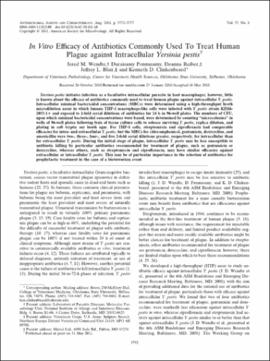| dc.contributor.author | Wendte, Jered M. | |
| dc.contributor.author | Ponnusamy, Duraisamy | |
| dc.contributor.author | Reiber, Deanna | |
| dc.contributor.author | Blair, Jeffrey L. | |
| dc.contributor.author | Clinkenbeard, Kenneth D. | |
| dc.date.accessioned | 2018-08-17T16:24:55Z | |
| dc.date.available | 2018-08-17T16:24:55Z | |
| dc.date.issued | 2011-08 | |
| dc.identifier | oksd_wendte_invitroefficacy_2011 | |
| dc.identifier.citation | Wendte, J. M., Ponnusamy, D., Reiber, D., Blair, J. L., & Clinkenbeard, K. D. (2011). In vitro efficacy of antibiotics commonly used to treat human plague against intracellular Yersinia pestis. Antimicrobial Agents and Chemotherapy, 55(8), 3752-3757. https://doi.org/10.1128/AAC.01481-10 | |
| dc.identifier.uri | https://hdl.handle.net/11244/301445 | |
| dc.description.abstract | Yersinia pestis initiates infection as a facultative intracellular parasite in host macrophages; however, little is known about the efficacy of antibiotics commonly used to treat human plague against intracellular Y. pestis. Intracellular minimal bactericidal concentrations (MBCs) were determined using a high-throughput broth microdilution assay in which human THP-1 macrophage-like cells were infected with Y. pestis strain KIM6-2053.1+ and exposed to 2-fold serial dilutions of antibiotics for 24 h in 96-well plates. The numbers of CFU, upon which minimal bactericidal concentrations were based, were determined by counting “microcolonies” in wells of 96-well plates following lysis of tissue culture cells to release surviving Y. pestis, replica dilution, and plating in soft tryptic soy broth agar. For THP-1 cells, streptomycin and ciprofloxacin had comparable efficacies for intra- and extracellular Y. pestis, but the MBCs for chloramphenicol, gentamicin, doxycycline, and amoxicillin were two-, three-, four-, and five 2-fold serial dilutions greater, respectively, for intracellular than for extracellular Y. pestis. During the initial stage of plague, intracellular Y. pestis may be less susceptible to antibiotic killing by particular antibiotics recommended for treatment of plague, such as gentamicin or doxycycline, whereas others, such as streptomycin and ciprofloxacin, may have similar efficacies against extracellular or intracellular Y. pestis. This may be of particular importance in the selection of antibiotics for prophylactic treatment in the case of a bioterrorism event. | |
| dc.format | application/pdf | |
| dc.language | en_US | |
| dc.publisher | American Society for Microbiology | |
| dc.rights | This material has been previously published. In the Oklahoma State University Library's institutional repository this version is made available through the open access principles and the terms of agreement/consent between the author(s) and the publisher. The permission policy on the use, reproduction or distribution of the material falls under fair use for educational, scholarship, and research purposes. Contact Digital Resources and Discovery Services at lib-dls@okstate.edu or 405-744-9161 for further information. | |
| dc.title | In vitro efficacy of antibiotics commonly used to treat human plague against intracellular Yersinia pestis | |
| osu.filename | oksd_wendte_invitroefficacy_2011.pdf | |
| dc.description.peerreview | Peer reviewed | |
| dc.identifier.doi | 10.1128/AAC.01481-10 | |
| dc.description.department | Veterinary Pathobiology | |
| dc.type.genre | Article | |
| dc.type.material | Text | |
| dc.subject.keywords | intracellular | |
| dc.subject.keywords | treatment | |
| dc.subject.keywords | antibacterial agent | |
| dc.subject.keywords | medical prescription | |
| dc.subject.keywords | treatment efficiency | |
| dc.subject.keywords | bacteria | |
| dc.subject.keywords | enterobacteriaceae | |
| dc.subject.keywords | infection | |
| dc.subject.keywords | bacteriosis | |
